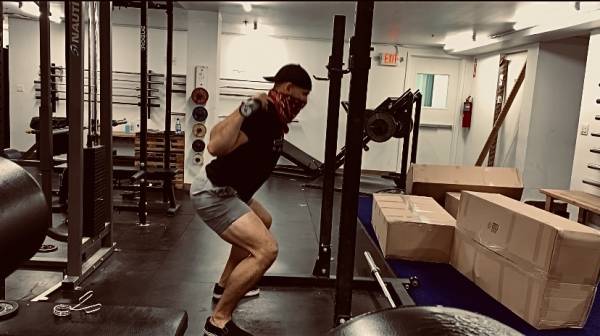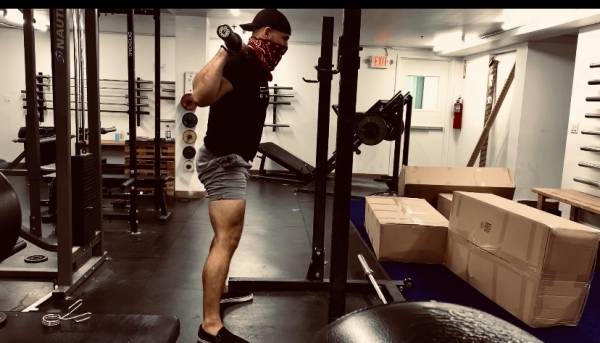There aren’t many quick and dynamic exercises that I’d recommend everyone learn and practice. But the landmine push press is something I’d suggest for almost anyone.
Once I’ve taught someone what I call the foundation movements that teach skill and body control related to every type of movement and exercise, I’ll pick movements that are best for them given their ability, background, and focus on physical fitness.
If you instill these foundation movements firmly from the start, learning more complex athletic movement and exercises becomes more intuitive.
If you want to understand these movements and the principles behind learning them with this particular strategy, I’m offering a comprehensive course teaching the why and how. If you live in or around New York City, you can sign up and learn in person at my gym JDI Barbell or run through the entire program online.
Once I help my clients build a bedrock without holes, I choose exercises that are easy to process and progress quickly. It’s different for everyone, but I do like to see everyone practice a couple of exercises.
One of these is the push press. I’ve raised a few eyebrows by saying this.
What Is the Push Press?
The push press is thought of as a secondary lift for Olympic weightlifting. I haven’t exactly been quiet about my opinion that Olympic weightlifting movements are best left alone unless you specifically want to dedicate time to that practice.
I have some clients who do a traditional barbell push press, but with others, I prefer to have them use kettlebells or dumbbells to build more stability or mobility.
The best version for field athletes, beginners to weight training, or those with restrictions, is the landmine push press.
Why Do the Landmine Push Press?
When you learn the push press, you learn how you can and should move in one coordinated athletic effort to move something heavy.
To do this right:
- It will help if you create stiffness in your entire trunk to deliver the force created from your lower body, as it pushes into the ground, to your upper body, and then, to hoist the load sitting on your shoulders overhead.
- You need to maintain balance and pressure through your feet to complete this quick jumping action with enough force and accuracy to push the bar overhead in the right direction.
But pushing weights directly overhead can sometimes do more harm than good.
Some athletes can’t stress their shoulders in this position if they want to stay healthy and strong for their sport, and some of the rest are just trying to be strong and fit and need to work out flexibility limitations first.
The landmine push press works around all this.
Pushing at an angle puts the shoulder and elbow in a position that can still train a more vertical pushing pattern without the same stress and flexibility demands on the shoulder.
Who Should Do the Push Press?
If you have had shoulder pain when pressing overhead because of an old injury or just from inactivity, the landmine push press is the perfect tool.
While you should keep working to recover the shoulder complex’s full dexterity, training for physical balance means you need to build athletic strength in pushing movements besides the bench press.
As you rebuild and push weight directly overhead, which indicates you again have your full natural mobility and stability in every movement direction, you will still improve strength and ability with this exercise.
Do both until you’re ready for the traditional push press, and continue doing them as a variation to continue building shoulder health and strength.
What Does the Push Press Do For You?
Just doing a strict landmine press builds a good deal of strength with total stability.
The upper-back muscles that control scapular movement and the shoulder’s stabilizing muscles are called to keep the barbell’s path straight.
This is especially true because you’re only holding the end of the barbell in this exercise.
As you press, it’s free to move in every direction, and it isn’t easy to keep in place. So those stabilizing muscles really have to do their job. You also need to create just as much stability from your trunk to get the shoulder to maintain the movement’s integrity and push the weight.
When you add the push press’s dynamic leg drive, you learn to produce stability and strength quicker and more efficiently because the movement is quick and explosive.
Turning a strict upper-body focused press into a full-body push also makes it possible to load yourself heavier overhead.
The weight that may be too heavy to press just from the shoulders can be heaved overhead with the momentum created from your legs extending and quickly locked out.
All of the upper back and shoulder supporting musculatures can then learn new static stability, strength levels, and improved coordination.
How Do You Do the Landmine Press?
If you can find a landmine press holder, that’s great. If you can’t, it doesn’t matter all that much. You can wedge it in any corner where it won’t cause damage or set it up as I do here:
- Load the bar, pick up the bar by the head (the end of the sleeve where you load the weight), and cup both your hands.
- Place the head of the bar almost directly in your sternum.
- Place your feet somewhere between hip and shoulder-width apart and flair your toes out.
- Brace and dip your knees to a similar position as you would if you were trying to jump as high as possible, but make sure that your knees track out toward your toes and your hips come slightly back without letting your chest fall forward.
- Keep your balance on your midfoot and keep your chest tall, fighting all urges to shift your weight all towards your heels, or let your chest cave, or round your upper back.
- While keeping the bar’s head in your chest, drive hard through your legs, pushing both feet into the ground.
- Explosively extend your knees as you would for a jump, still making sure you’re pushing through the whole foot of both legs.
- As you come upon the balls of your feet from this explosive drive, shrug your shoulders. The barbell should fly off your chest a little.
- Without hesitation, keep your shoulders shrugged and quickly extend your elbows pushing the bar at a 45-degree angle (almost at the crown of your head).
- Try to time the end lockout of your elbows to happen at the very same time your heels touch back down to the floor.


What Are Your Options?
I prefer the landmine push press with two arms because of how much you can overload yourself with it, but single arm variations can be better for some people.
If you really need to recover balance in the body or work on single-side strength and stability to improve a nagging injury or reduce some glaring asymmetry, the single-arm landmine push is one of the best and safest ways to accomplish it.
Just place the head of the bar in one hand directly at the head of your shoulder and do the exercise the same way you would with two hands.
Both the single and double arm variations of this exercise are great at building strength with less risk.
The scapula moves in a position along the rib cage that keeps it in a more anatomically strong and stable position when you press with a neutral grip (thumbs facing up).
The angle at which you push the bar fixes you in a position where you can’t contort your body to grind through a rep that you really shouldn’t.
You either lockout smoothly or not at all.
However, you should do these over some matted area so that if you do fail a rep, you won’t hesitate to let the bar drop in front of you instead of lowering it in a bad position.
If someone hurts themselves doing this exercise, they most likely did so when lowering the bar back to the ground.
You can stay braced and squat to lower it to drop it at waist height with matting underneath.
When You’re Ready for the Challenge
Learning the timing for the push press is challenging, and it develops athletic ability. Transitioning to a push jerk can test you further.
The push press and push jerk are similar with one difference.
In the push jerk, you lock your arms out and receive the bar with your legs bent in a quarter squat.
The timing of the dip and drive is the same, but instead of ending with your legs straight and standing fully as you do in the push press, you use the weight to push you back into a quarter squat, then, stand from there, having already received the weight supported with locked elbows.
Not only is this going to challenge your speed of movement and coordination, but it will also let you handle heavier weights and build even higher levels of total body strength.
It cannot be easy to learn if you’ve never practiced it, but if you understand the basic principles of stability and balance, it just needs a little practice.






